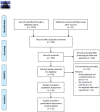Associations between C-reactive protein and white blood cell count, occurrence of delayed cerebral ischemia and poor outcome following aneurysmal subarachnoid hemorrhage: a systematic review and meta-analysis
- PMID: 33423218
- PMCID: PMC7796813
- DOI: 10.1007/s13760-020-01496-y
Associations between C-reactive protein and white blood cell count, occurrence of delayed cerebral ischemia and poor outcome following aneurysmal subarachnoid hemorrhage: a systematic review and meta-analysis
Abstract
This review and meta-analysis investigated associations of systemic inflammatory marker C-reactive protein (CRP) and white blood cell count (WBC) with occurrence of delayed cerebral ischemia (DCI) and poor functional outcome after aneurysmal subarachnoid hemorrhage (aSAH). Pubmed, EMBASE, and CENTRAL databases were searched until November 30, 2019, selecting prospective and retrospective studies of patients with spontaneous SAH due to ruptured aneurysm. Outcome measures were occurrence of DCI, defined as new focal neurological deficit or a deterioration of consciousness; and/or a new infarct on computed tomography or magnetic resonance imaging that was not visible initially. Occurrence of poor functional outcome at follow-up were measured by modified Rankin Scale or Glasgow outcomes scale. Fifteen studies analyzing data of 3268 patients with aSAH were included. Meta-analysis revealed early increase in CRP was significantly associated with higher risk of occurrence of DCI (pooled OR 1.30, 95% CI 1.10-1.54; P = 0.002), whereas not with poor functional outcome (pooled OR 1.02, 95% CI 1.00-1.04, P = 0.052). No significant associations between early increase in WBC and DCI (pooled OR 1.13, 95% CI 0.95-1.34; P = 0.179) were observed, whereas increase in WBC was significantly associated with increased risk of poor functional outcome (pooled OR 1.17, 95% CI 1.07-1.28, P = 0.001). Early increase in blood CRP appears to correlate with DCI after SAH, while increase in WBC correlates with poor functional outcome. However, strong conclusion cannot be made due to the small study number, between-study heterogeneity and suspicion of uncontrolled factors. Whether early phase CRP and WBC may serve as prognostic markers for aSAH needs more investigation.
Keywords: Aneurysmal subarachnoid hemorrhage; Biomarker; C-reactive protein; Delayed cerebral ischemia; White blood cell count.
© 2021. Belgian Neurological Society.
Conflict of interest statement
All authors certify that they have no affiliations with or involvement in any organization or entity with any financial interest (such as honoraria; educational grants; participation in speakers’ bureaus; membership, employment, consultancies, stock ownership, or other equity interest; and expert testimony or patent-licensing arrangements), or non-financial interest (such as personal or professional relationships, affiliations, knowledge or beliefs) in the subject matter or materials discussed in this manuscript.
Figures
Similar articles
-
Predictive effects of admission white blood cell counts and hounsfield unit values on delayed cerebral ischemia after aneurysmal subarachnoid hemorrhage.Clin Neurol Neurosurg. 2022 Jan;212:107087. doi: 10.1016/j.clineuro.2021.107087. Epub 2021 Dec 7. Clin Neurol Neurosurg. 2022. PMID: 34929583
-
Admission neutrophil-lymphocyte ratio predicts delayed cerebral ischemia following aneurysmal subarachnoid hemorrhage.J Neurointerv Surg. 2019 Nov;11(11):1135-1140. doi: 10.1136/neurintsurg-2019-014759. Epub 2019 Apr 12. J Neurointerv Surg. 2019. PMID: 30979846
-
C-reactive protein elevation predicts in-hospital deterioration after aneurysmal subarachnoid hemorrhage: a retrospective observational study.Acta Neurochir (Wien). 2022 Jul;164(7):1805-1814. doi: 10.1007/s00701-022-05256-0. Epub 2022 May 26. Acta Neurochir (Wien). 2022. PMID: 35618852 Free PMC article.
-
CT Perfusion for Identification of Patients at Risk for Delayed Cerebral Ischemia during the Acute Phase after Aneurysmal Subarachnoid Hemorrhage: A Meta-analysis.Neurol India. 2019 Sep-Oct;67(5):1235-1239. doi: 10.4103/0028-3886.271235. Neurol India. 2019. PMID: 31744949
-
Clinical Burden of Angiographic Vasospasm and Its Complications After Aneurysmal Subarachnoid Hemorrhage: A Systematic Review.Neurol Ther. 2023 Apr;12(2):371-390. doi: 10.1007/s40120-022-00436-7. Epub 2023 Jan 7. Neurol Ther. 2023. PMID: 36609962 Free PMC article. Review.
Cited by
-
Inflammatory Markers as Predictors of Shunt Dependency and Functional Outcome in Patients with Aneurysmal Subarachnoid Hemorrhage.Biomedicines. 2023 Mar 23;11(4):997. doi: 10.3390/biomedicines11040997. Biomedicines. 2023. PMID: 37189615 Free PMC article.
-
A novel visual dynamic nomogram to online predict the risk of unfavorable outcome in elderly aSAH patients after endovascular coiling: A retrospective study.Front Neurosci. 2023 Jan 10;16:1037895. doi: 10.3389/fnins.2022.1037895. eCollection 2022. Front Neurosci. 2023. PMID: 36704009 Free PMC article.
-
Prognostic significance of white blood cell to platelet ratio in delayed cerebral ischemia and long-term clinical outcome after aneurysmal subarachnoid hemorrhage.Front Neurol. 2023 May 18;14:1180178. doi: 10.3389/fneur.2023.1180178. eCollection 2023. Front Neurol. 2023. PMID: 37273707 Free PMC article.
-
The Prognostic Value of Neutrophil-to-Lymphocyte Ratio in Patients With Aneurysmal Subarachnoid Hemorrhage: A Systematic Review and Meta-Analysis of Observational Studies.Front Neurol. 2021 Nov 15;12:745560. doi: 10.3389/fneur.2021.745560. eCollection 2021. Front Neurol. 2021. PMID: 34867727 Free PMC article.
-
Risk factors and predictive indicators of rupture in cerebral aneurysms.Front Physiol. 2024 Sep 5;15:1454016. doi: 10.3389/fphys.2024.1454016. eCollection 2024. Front Physiol. 2024. PMID: 39301423 Free PMC article. Review.
References
Publication types
MeSH terms
Substances
LinkOut - more resources
Full Text Sources
Other Literature Sources
Research Materials
Miscellaneous




